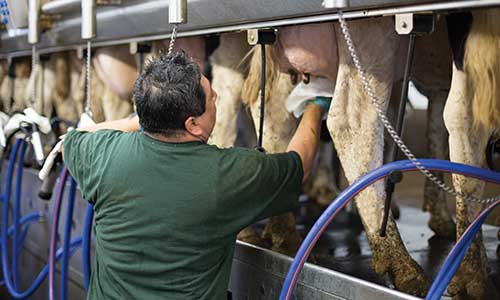The author is the dairy development manager for Vita Plus of Madison, Wis. He is a member of the board of directors with Citizens State Bank of Loyal, Wis.

Getting a firm handle on farm financials will be critical to long-term business success. If your operation needs to get up to speed, now would be a good time as milk prices are favorable by historic standards and feed prices are moderating.
Here we are in yet another year with continual changes and uncertainty. Have you figured that this is a never-ending occurrence on the business side of agriculture? One of the biggest common unknowns is the weather. Regardless if you raise all of your forage and grain or you buy it, everyone is affected one way or another by weather. We still cannot cover the fields and dairy with a protective tent or greenhouse. Just like the weather is always with you, the farm financials will always be with you.
Even with unpredictable weather and markets, there are dairy producers who not only survive but continue to make constant progress. Maybe not so much in some years but overall they just seem to keep getting ahead. They deal with the same ups and downs as everyone else.
The sun does not shine any different on their side of the fence and rain does not discriminate in a neighborhood. So, what are they watching and doing that is so different? They, for the most part, seem to be in the right place at the right time and make overall good decisions.
Numbers drive decisions
These farmers focus first on their financials. Financials measure how well they have done in the past, how they are doing today and how decisions might evolve in the future.
1. Dairy producers who succeed keep their balance sheet on the backside of their mind. They are thinking first and then making decisions. The thought process goes like this. "This decision that I am making today, what are the short- and long-term effects on my balance sheet? I want to make sure my balance sheet grows because of this move!"
2. They watch their expenses. I did not say they are cheap, but the age-old question is asked internally and many times discussed with others. "Is this an expense or an investment?" Every dollar spent must be necessary.
3. They know their cost of production (COP). This may seem like an elementary question that is always brought up but it still gets met with too many blank stares when asked.
The price of milk may be higher than it was in 2009 or even in the last 20 years, but everyone is aware of how rising expenses have eroded bottom lines. Dairy producers handle a great deal of money, but margins continue to be tight and will probably stay that way
4. Enterprise accounting is becoming much more common. Even on dairies where all of the crops are fed to the milking herd, forage and grain production costs are separately monitored for each enterprise.
Here is a good question. "If I did not feed these crops to my cows, what else could I do with them or what else could I raise?" Better yet, where is the money made in the crops or cows? Of course, we always have to remember when you milk cows you have made a long-term decision.
Cropping costs, as with other farm-related costs, have skyrocketed. It is now more important than ever to know the real cost of producing feed. Forage varieties of all types need to be selected for protein, energy and fiber content for the ration when the TMR is delivered to the herd.
Enterprise evaluation has been given a lot of press in the last year with the realization of what it really costs to feed young stock. No longer is that enterprise a forgotten area where you just give the young stock what the cow cannot eat. There are some real costs here and you need to know it.
5. Successful dairy producers know that generating gross income is important. In other words, you have to pump out milk. The average U.S. milk cow today produces 21,000 pounds of milk. USDA predicts that the average cow will be producing 25,000 pounds of milk by 2022.
Producing milk is more than milking cows. It is genetics, genomics, breeding on time, sorting out tools that work and avoiding the milk-robbing metabolic problems that often occur, plus or minus 30 days of calving.
6. Dairy producers that understand the importance of their financials keep a 2:1 current ratio on their balance sheets. That means they have $2 of current assets, cash, feed and other assets that will be turned into cash in the next 12 months.
Compare current assets to current liabilities which are payables and principal due in the next 12 months. This is called liquidity. They also keep operating lines of credit available through their lender, so when a real opportunity comes up, they will have the advantage of reacting fast to seal the deal.
7. Successful dairy producers monitor and use debt to their advantage. When $1 is borrowed they are generating 70 cents of gross income every year after making that investment. Some are reaching $1.25 of gross income each year. If interest rates are at 5 percent, they are getting a return on their equity of 14 percent or a return on their total assets of 8 percent. They are generating a sizable amount of net income.
These dairy producers rely on trusted consultants in financing, accounting and, in most cases, lending. However, every successful dairy producer must know they "Have to know the numbers" at the end of the day. These producers know the financials are not going away, and the better managers who know their farm's numbers are often in a stronger financial position. If you're in this business, the financials will always be with you.
This article appears on page 726 of the October 25, 2013 issue of Hoard's Dairyman.

Getting a firm handle on farm financials will be critical to long-term business success. If your operation needs to get up to speed, now would be a good time as milk prices are favorable by historic standards and feed prices are moderating.
Here we are in yet another year with continual changes and uncertainty. Have you figured that this is a never-ending occurrence on the business side of agriculture? One of the biggest common unknowns is the weather. Regardless if you raise all of your forage and grain or you buy it, everyone is affected one way or another by weather. We still cannot cover the fields and dairy with a protective tent or greenhouse. Just like the weather is always with you, the farm financials will always be with you.
Even with unpredictable weather and markets, there are dairy producers who not only survive but continue to make constant progress. Maybe not so much in some years but overall they just seem to keep getting ahead. They deal with the same ups and downs as everyone else.
The sun does not shine any different on their side of the fence and rain does not discriminate in a neighborhood. So, what are they watching and doing that is so different? They, for the most part, seem to be in the right place at the right time and make overall good decisions.
Numbers drive decisions
These farmers focus first on their financials. Financials measure how well they have done in the past, how they are doing today and how decisions might evolve in the future.
1. Dairy producers who succeed keep their balance sheet on the backside of their mind. They are thinking first and then making decisions. The thought process goes like this. "This decision that I am making today, what are the short- and long-term effects on my balance sheet? I want to make sure my balance sheet grows because of this move!"
2. They watch their expenses. I did not say they are cheap, but the age-old question is asked internally and many times discussed with others. "Is this an expense or an investment?" Every dollar spent must be necessary.
3. They know their cost of production (COP). This may seem like an elementary question that is always brought up but it still gets met with too many blank stares when asked.
The price of milk may be higher than it was in 2009 or even in the last 20 years, but everyone is aware of how rising expenses have eroded bottom lines. Dairy producers handle a great deal of money, but margins continue to be tight and will probably stay that way
4. Enterprise accounting is becoming much more common. Even on dairies where all of the crops are fed to the milking herd, forage and grain production costs are separately monitored for each enterprise.
Here is a good question. "If I did not feed these crops to my cows, what else could I do with them or what else could I raise?" Better yet, where is the money made in the crops or cows? Of course, we always have to remember when you milk cows you have made a long-term decision.
Cropping costs, as with other farm-related costs, have skyrocketed. It is now more important than ever to know the real cost of producing feed. Forage varieties of all types need to be selected for protein, energy and fiber content for the ration when the TMR is delivered to the herd.
Enterprise evaluation has been given a lot of press in the last year with the realization of what it really costs to feed young stock. No longer is that enterprise a forgotten area where you just give the young stock what the cow cannot eat. There are some real costs here and you need to know it.
5. Successful dairy producers know that generating gross income is important. In other words, you have to pump out milk. The average U.S. milk cow today produces 21,000 pounds of milk. USDA predicts that the average cow will be producing 25,000 pounds of milk by 2022.
Producing milk is more than milking cows. It is genetics, genomics, breeding on time, sorting out tools that work and avoiding the milk-robbing metabolic problems that often occur, plus or minus 30 days of calving.
6. Dairy producers that understand the importance of their financials keep a 2:1 current ratio on their balance sheets. That means they have $2 of current assets, cash, feed and other assets that will be turned into cash in the next 12 months.
Compare current assets to current liabilities which are payables and principal due in the next 12 months. This is called liquidity. They also keep operating lines of credit available through their lender, so when a real opportunity comes up, they will have the advantage of reacting fast to seal the deal.
7. Successful dairy producers monitor and use debt to their advantage. When $1 is borrowed they are generating 70 cents of gross income every year after making that investment. Some are reaching $1.25 of gross income each year. If interest rates are at 5 percent, they are getting a return on their equity of 14 percent or a return on their total assets of 8 percent. They are generating a sizable amount of net income.
These dairy producers rely on trusted consultants in financing, accounting and, in most cases, lending. However, every successful dairy producer must know they "Have to know the numbers" at the end of the day. These producers know the financials are not going away, and the better managers who know their farm's numbers are often in a stronger financial position. If you're in this business, the financials will always be with you.









